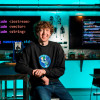Kodu will teach you (or your kid) about programming
The first computer program I ever wrote, in the second grade, was composed in pencil and ran on the platform known as my friend Nicholas. We were about to start learning Logo, the program that teaches kids how to draw things on the screen by writing out commands for a turtle. Before we got some face time with an Apple II, we had to act out the simple commands—Forward 10 steps, Left 90 degrees—in real life. I eventually succeeded in programming Nicholas to walk in a square.
Logo is the most memorable in a lineage of games that have tried to make programming fun and intuitive. I was reminded of it recently when I saw a demonstration of Kodu, a newly released video game from Microsoft aimed at the 9-and-over crowd. Kodu is light years beyond Logo, with modern 3-D graphics, a world players can landscape to their liking, and a cast of characters that isn't limited to the Terrapene genus. But the mission is pretty much the same: to place kids in an open-ended environment and arm them with a simple language that lets them build things. At the risk of blaspheming my youth, I dare say that Kodu is more fun than Logo. It's also a reminder that the mission of games like these is not actually to teach kids how to write code. It's to teach them how to think like programmers.









































































